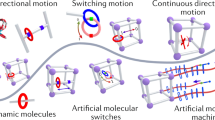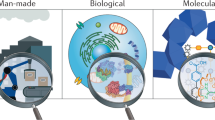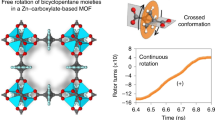Abstract
Although metal–organic frameworks are extensive in number and have found widespread applications, there remains a need to add complexity to their structures in a controlled manner. It is inevitable that frameworks capable of dynamics will be required. However, as in other extended structures, when they are flexible, they fail. We propose that mechanically interlocked molecules be inserted covalently into the rigid framework backbone such that they are mounted as integrated components, capable of dynamics, without compromising the fidelity of the entire system. We have coined the term 'robust dynamics' to describe constructs where the repeated dynamics of one entity does not affect the integrity of any others linked to it. The implication of this concept for dynamic molecules, whose performance has the disadvantages of random motion, is to bring them to a standstill in three-dimensional extended structures and thus significantly enhance their order, and ultimately their coherence and performance.
This is a preview of subscription content, access via your institution
Access options
Subscribe to this journal
Receive 12 print issues and online access
$259.00 per year
only $21.58 per issue
Buy this article
- Purchase on Springer Link
- Instant access to full article PDF
Prices may be subject to local taxes which are calculated during checkout




Similar content being viewed by others
References
Long, J. R. & Yaghi O. M. The pervasive chemistry of metal-organic frameworks. Chem. Soc. Rev. 38, 1213–1214 (2009).
Yaghi, O. M. et al. Reticular synthesis and the design of new materials. Nature 423, 705–714 (2003).
Horike, S., Shimomura, S. & Kitagawa, S. Soft porous crystals. Nature Chem. 1, 695–704 (2009).
Serre, C. et al. Role of solvent-host interactions that lead to very large swelling of hybrid frameworks. Science 315, 1828–1831 (2007).
Maji, T. K., Matsuda, R. & Kitagawa, S. A flexible interpenetrating coordination framework with a bimodal porous functionality. Nature Mater. 6, 142–148 (2007).
Balzani, V., Credi, A. & Venturi, M. Molecular Devices and Machines – Concepts and Perspectives for the Nanoworld (Wiley-VCH, 2008).
Stoddart, J. F. The chemistry of the mechanical bond. Chem. Soc. Rev. 38, 1802–1820 (2009).
Diederich, F. & Stang, P. J. (eds) Templated Organic Synthesis (Wiley-VCH, 1999).
Choi, J. W. et al. Ground-state equilibrium thermodynamics and switching kinetics of bistable [2]rotaxane switches in solution, polymer gels, and molecular electronic devices. Chem. Eur. J. 12, 261–279 (2006).
Li, H., Eddaoudi, M., O'Keeffe, O. & Yaghi, O. M. Design and synthesis of an exceptionally stable and highly porous metal-organic framework. Nature 402, 276–279 (1999).
Ockwig, N., Friedrichs, O. D., O'Keeffe, M. & Yaghi, O. M. Reticular chemistry: occurrence and taxonomy of nets, and grammar for the design of frameworks. Acc. Chem. Res. 38, 176–182 (2005).
Eddaoudi, M. et al. Systematic design of pore size and functionality in metal-organic frameworks and application in methane storage. Science 295, 469–472 (2002).
Schill, G. Catenanes, Rotaxanes and Knots (Academic Press, 1971).
Sauvage, J-P. & Dietrich-Buchecker, C. (eds) Molecular Catenanes, Rotaxanes and Knots: A Journey Through the World of Molecular Topology (Wiley-VCH, 1999).
Bissell, R. A., Cordova, E., Kaifer, A. E. & Stoddart, J. F. A chemically and electrochemically switchable molecular shuttle. Nature 369, 133–137 (2004).
Livoreil, A., Dietrich-Buchecker, C. O. & Sauvage, J-P. Electrochemically triggered swinging of a [2]catenane. J. Am. Chem. Soc. 116, 9399–9400 (1994).
Kay, E. R., Leigh, D. A. & Zerbetto, F. Synthetic molecular motors and mechanical machines. Angew. Chem. Int. Ed. 46, 72–191 (2007).
Chichak, K. S. et al. Molecular Borromean rings. Science 304, 1308–1312 (2004).
Klajn, R. et al. Metal nanoparticles functionalized with molecular and supramolecular switches. J. Am. Chem. Soc. 131, 4233–4235 (2009).
Collier, C. P. et al. A [2]catenane-based solid-state electronically reconfigurable switch. Science 289, 1172–1175 (2000).
Juluri, B. K. et al. A mechanical actuator driven electrochemically by artificial molecular muscles. ACS Nano 3, 291–300 (2009).
Luo, Y. et al. Two-dimensional molecular electronic circuits. ChemPhysChem 3, 519–525 (2002).
Green, J. E. et al. A 160-kilobit molecular electronic memory patterned at 1011 bits per square centimetre. Nature 445, 414–417 (2007).
Li, Q. et al. Docking in metal-organic frameworks. Science 325, 855–859 (2009).
Kim, K. Entering the recognition domain. Nature Chem. 1, 603–604 (2009).
Alavi, S. Selective guest docking in metal-organic framework materials. ChemPhysChem 11, 55–57 (2010).
Zhao, Y-L. et al. Rigid strut-containing crown ethers and [2]catenanes for incorporation into metal-organic frameworks. Chem. Eur. J. 15, 13356–13380 (2009).
Anelli, P-L. et al. Molecular meccano 1. [2]Rotaxane and a [2]catenane made to order. J. Am. Chem. Soc. 114, 193–218 (1992).
Balzani, V. et al. Constructing molecular machinery. A chemically switchable [2]catenane. J. Am. Chem. Soc. 122, 3542–3543 (2000).
Li, Q. et al. A metal-organic framework replete with ordered donor-acceptor catenanes. Chem. Commun. 46, 380–382 (2010).
Kandra, K., Koike, T., Endo, K. & Shibata, T. The first asymmetric Sonogashira coupling for enantioselective generation of planar chirality in paracyclophanes. Chem. Commun. 1870–1872 (2009).
Glink, P. T. & Stoddart, J. F. Concept transfer from the life sciences into materials science. Pure Appl. Chem. 70, 419–424 (1998).
Stoddart, J. F. Thither supramolecular chemistry. Nature Chem. 1, 14–15 (2009).
Acknowledgements
We acknowledge the Department of Energy (BES-Separation Program), the Department of Defense (Defense Reduction Threat Agency), the Air Force Office of Scientific Research under their Multidisciplinary University Research Initiative (FA9550-07-1-0534), the Microelectronics Advanced Research Corporation and its Focus Center Research Program, the Center on Functional Engineered Nano-Architectonics, and the NSF-MRSEC Program through the Northwestern University Materials Research Science and Engineering Center for their continued support of this research.
Author information
Authors and Affiliations
Corresponding authors
Rights and permissions
About this article
Cite this article
Deng, H., Olson, M., Stoddart, J. et al. Robust dynamics. Nature Chem 2, 439–443 (2010). https://doi.org/10.1038/nchem.654
Published:
Issue Date:
DOI: https://doi.org/10.1038/nchem.654
This article is cited by
-
Functional dynamics in framework materials
Communications Chemistry (2023)
-
Stimuli-responsive metal–organic frameworks enabled by intrinsic molecular motion
Nature Materials (2022)
-
Controlling dynamics in extended molecular frameworks
Nature Reviews Chemistry (2022)
-
A spin-crossover framework endowed with pore-adjustable behavior by slow structural dynamics
Nature Communications (2022)
-
The development of molecule-based porous material families and their future prospects
Nature Materials (2022)



